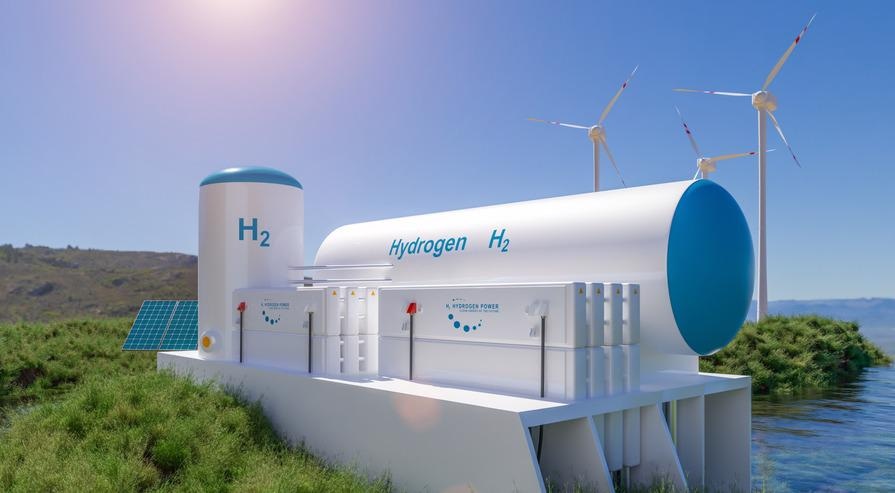Making the switch from fossil fuels to renewables is fundamental to tackling climate change. However, large-scale clean energy options are still facing considerable obstacles. Recent research from a team at Curtin University, Australia, has demonstrated a new method of catalyzing the reaction that splits water to produce hydrogen for clean energy. This method has the potential to further the widespread adoption of renewable energy.

Image Credits: Audio und werbung/Shutterstock.com
Shifting from Fossil Fuels to Renewables
For around 150 years, non-renewable energy sources such as coal, oil, and other fossil fuels have powered human civilization. While these sources provide an easy to access, continuous form of power, they also emit greenhouse gases that prevent heat from escaping the atmosphere. As a result, global average temperatures and sea levels have risen, extreme weather events have become more frequent, and ecosystems have been significantly impacted.
Implementing solutions to tackle climate change is of utmost importance to protect the planet for future generations. In discussions about climate change, switching from fossil fuels to renewable energy is almost always considered the most impactful solution.
Fortunately, efforts to shift from fossil fuels to renewable energy have heated up in recent years, with renewable energy growing faster than any other energy form each year since 2011. Almost one-third of the world’s electricity supply now comes from renewable energy.
However, the journey to securing 100% clean, renewable energy for the world is far from complete. There are still many challenges to overcome to ensure that renewable energy is fully sustainable and that it does not recruit any environmentally damaging processes at any stage.
Overcoming Hydrogen Production's Reliance on Precious Metals
Hydrogen is one emerging clean energy source that can provide the large-scale energy source needed to fulfill the world’s increasing demand for power. Currently, producing hydrogen power involves using precious metals, such as platinum, to catalyze the reaction that splits water into hydrogen and oxygen. This process is relatively expensive and limited in its efficiency.
Now, scientists have developed a method of accelerating the reaction to produce hydrogen using nickel and cobalt. The technique, outlined in a publication in the journal Nano Energy, offers a cheaper and more efficient electrocatalyst to produce green hydrogen from water. The method would make large-scale clean energy production possible, a solution that could significantly reduce global emissions and help to reverse climate change.
Scientists at Curtin’s School of Molecular and Life Sciences have discovered that adding nickel and cobalt to catalysts, such as two-dimensional iron-sulfur nanocrystals, that were previously deemed ineffective, greatly enhances their performance. Because of this, cheaper catalysts can now be used to power the reaction that splits water to produce hydrogen.
The energy industry now has a relatively low-cost, high-efficiency option for generating large-scale clean energy.
Future Challenges of Attaining Sustainable Hydrogen
The work conducted at Curtin represents a significant step towards reliably replacing our global fossil fuel energy supply with clean energy. However, while advancements have been made in terms of efficiency and cost-effectiveness, there remains the problem of ensuring renewable energy sources are fully sustainable.
Research has shown that while renewable energy sources may not directly contribute to emissions, processes involved at any stage of the clean energy generation operation may themselves contribute.
The use of metal in the reaction process required to split water to produce hydrogen is reliant on mining. It is well known that mining for the metals used in this reaction causes direct and indirect damage to the environment. For example, mining causes deforestation, soil erosion, soil and water systems contamination, noise pollution, and air pollution.
Before hydrogen power can be considered truly sustainable, research and development into ways to produce hydrogen that do not cause harm to the environment are needed. To secure a future where the planet runs 100% on clean energy, much more effort is needed to transform renewable energy processes to prevent adverse environmental impacts. There is great potential to develop such methods, and innovations are urgently needed to help the world shift to clean energy and meet these goals.
References and Further Reading
Javaid, S., Xu, X., Chen, W., Chen, J., Hsu, H., Wang, S., Yang, X., Li, Y., Shao, Z., Jones, F. and Jia, G., (2021) Ni2+/Co2+ doped Au-Fe7S8 nanoplatelets with exceptionally high oxygen evolution reaction activity. Nano Energy, 89, p.106463. Available at: https://doi.org/10.1016/j.nanoen.2021.106463
Christina Nunez. (2019) Renewable energy, explained. [online]. National Geographic. Available at: https://www.nationalgeographic.com/environment/article/renewable-energy
Haddaway, N., Cooke, S., Lesser, P., Macura, B., Nilsson, A., Taylor, J. and Raito, K., (2019) Evidence of the impacts of metal mining and the effectiveness of mining mitigation measures on social–ecological systems in Arctic and boreal regions: a systematic map protocol. Environmental Evidence, 8(1).Available at: https://doi.org/10.1186/s13750-019-0152-8
(2019) Why is renewable energy important?. [online]. Ren21. Available at: https://www.ren21.net/why-is-renewable-energy-important/
Curtin University. (2021) Gamechanger for clean hydrogen production, Curtin research finds. [online]. Available at: https://news.curtin.edu.au/media-releases/gamechanger-for-clean-hydrogen-production-curtin-research-finds/
Disclaimer: The views expressed here are those of the author expressed in their private capacity and do not necessarily represent the views of AZoM.com Limited T/A AZoNetwork the owner and operator of this website. This disclaimer forms part of the Terms and conditions of use of this website.